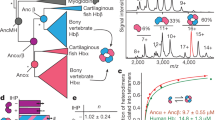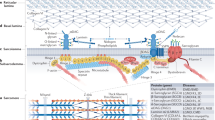Abstract
HAEMOGLOBINS from various strains of mice have been referred to as single (Hbs) or diffuse (Hbd)1–3, according to the appearance of the electrophoretic patterns of the haemoglobin haemolysates. Popp1 has suggested that two allelic genes are responsible for the single or double (diffuse) bands. Recently, two investigators4,5 have shown independently that the diffuse patterns are the result of polymerization of mouse haemoglobins to eight-chain double molecules, and hence from 4S to 7S tetramers. This transformation can be enhanced by reduced glutathione (GSH) or oxidized glutathione (GSSG) and inhibited by iodoacetamide (IOA). These polymerization products, frequently encountered with inbred strains and with domestic mice (Mus musculus), are not often found with wild species.
This is a preview of subscription content, access via your institution
Access options
Subscribe to this journal
Receive 51 print issues and online access
$199.00 per year
only $3.90 per issue
Buy this article
- Purchase on Springer Link
- Instant access to full article PDF
Prices may be subject to local taxes which are calculated during checkout
Similar content being viewed by others
References
Popp, R. A. J., Heredity, 53, 142 (1962).
Ranney, H. M., Smith, G. M., and Gluechsohn-Waelsch, S., Nature, 188, 212 (1960).
Craig, M. L., and Russell, E. S., Nature, 140, 198 (1963).
Riggs, A., Nature, 147, 621 (1965).
Thompson, R. B., and Hewett, H. B. (personal communication).
Gough, B. J., and Kilgore, S. S., J. Mamm., 45, 421 (1964).
Wintrobe, M. M., Folia Haematol., 51, 32 (1933).
Depelchin, A., Ann. Med. Vet., 100, 325 (1956).
Scarbough, R. A., Yale J. Biol. and Med., 3, 63 (1931).
Kamenoff, R. J., Proc. Soc. Exp. Biol. and Med., 36, 411 (1937).
Russell, E. S., Neufeld, E. F., and Higgins, C. T., Proc. Soc. Exp. Biol. and Med., 78, 761 (1951).
Wintrobe, M. M., Clinical Hematology, fifth ed., 108 (Lea and Febiger, 1958).
Author information
Authors and Affiliations
Rights and permissions
About this article
Cite this article
THOMPSON, R., HEWETT, H., KILGORE, S. et al. Haemoglobin Variants in a Species of Wild Mice—Peromyscus maniculatus. Nature 210, 1063–1064 (1966). https://doi.org/10.1038/2101063a0
Issue Date:
DOI: https://doi.org/10.1038/2101063a0
This article is cited by
-
Genetic and developmental variation of hemoglobin in the deermouse, Peromyscus maniculatus
Biochemical Genetics (1976)
-
Hemoglobin polymorphism in the deer mouse,Peromyscus maniculatus
Biochemical Genetics (1968)
Comments
By submitting a comment you agree to abide by our Terms and Community Guidelines. If you find something abusive or that does not comply with our terms or guidelines please flag it as inappropriate.



